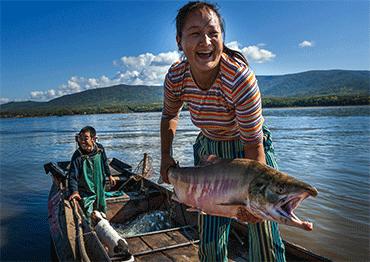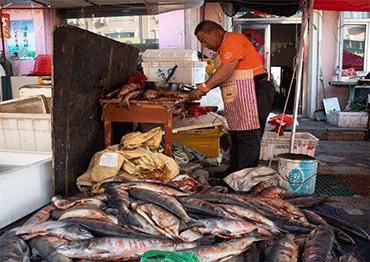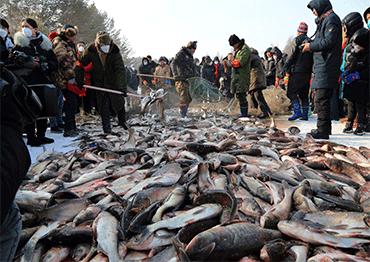s the freezing cold days of late December set in, the winter fishing season began in Northeast China, where temperatures can hover around -20 C. For more than 1,000 years, ethnic groups such as the Hezhe and ethnic Mongolians subsisted on hunting and fishing due to the area’s rich forest and river resources. In recent years, local authorities have been promoting traditional winter fishing to attract tourism and boost their economies.
Among the main catches are chum salmon. Averaging three to six kilograms, the species is one of the largest salmon of the Pacific. Born in freshwater rivers, juvenile salmon migrate to the North Pacific, and after three years return to their spawning grounds. During their journey, which can cover tens to thousands of kilometers, they face threats from bears and wolves, dams and changing water conditions.
Before the 1980s, chum salmon were an important source of revenue for fishers and governments along the Heilongjiang River. In addition, the migrating species brings ocean nutrients to freshwater areas.
However, their populations have dwindled due to water pollution, dam construction and climate change. Since the late 1980s, China has taken actions to protect the fish.
Leading the charge is Take Me Home, a project launched in 2014 and organized by Forever Nature Capital Foundation, an NGO based in Heilongjiang Province. Their mission is to protect and restore the sustainable ecological development of rivers, as well as to create freshwater ecosystem environments.
In 2021, the project was listed among the 100+ Biodiversity Positive Practices and Actions Around the World, an initiative guided by the UN’s COP15 biodiversity conference and launched by the China Environmental Protection Foundation and the Shenzhen-based Paradise International Foundation.
In a recent interview with China News Service, Zhang Tianhang, cofounder and secretary general of the Forever Nature Capital Foundation and head of the Take Me Home project, shared his experiences and views on chum salmon protection in China.
China News Service: What is the current status of chum salmon in China?
Zhang Tianhang: Chum salmon are born in freshwater and grow in the ocean. A chum salmon has a life cycle of three to five years. They used to be widely distributed in the Heilongjiang River, Tumen River and Suifen River (all in China’s Northeast). But their population has sharply declined over the past three decades.
In 2015 during our field research, Take Me Home found chum salmon in the Fuyuan section of the Heilongjiang River, but not in the Songhua River (China’s northernmost river which flows into the Heilongjiang River in Fuyuan). Masu salmon can still be found in the Tumen (which creates the China-North Korea and Russia-North Korea border) and Suifen rivers, while pink salmon have not been spotted for years.
Chum salmon and Atlantic salmon are both from the Salmonidae family. There is a lot to learn from international salmon protection. Unlike animals under China’s national first-class protection status, such as giant pandas, Siberian tigers and golden snub-nosed monkeys, chum salmon is an economic fish species that is crucial to the livelihoods of many fishers. Given this, China follows the international practice of sustainable fishing, which balances protection and utilization.
CNS: What measures have proven effective in China’s chum salmon protection efforts?
ZT: Chum salmon have very low prospects of fertilization and survival in nature. This is why artificial cultivation and release are among the primary methods of restoring chum salmon numbers. The equipment and technologies adopted in China can improve the survival rate of chum salmon to above 80 percent.
It is common practice in China to collect adult parent salmon from October to early November when salmon return to the rivers in the country’s northeast, and have them spawn at advanced hatching facilities. Young salmon grow in this system and are released to migrate to the ocean in late April and May the following year when the ice melts.
Take Me Home built release stations in three locations: Fuyuan on the Heilongjiang River, Dongning on the Suifen River and Hunchun on the Tumen River.
The survival rate of chum salmon is increasing through improvements in breeding technology and management. For example, at a release spot in Xiawazi Village, Hunchun, Jilin Province, a hatching system can process 15 million salmon eggs in a single hatching period. A similar system in a coldwater fish project in Jiefang Village, also in Hunchun, can hatch 16-20 million salmon eggs in a hatching period.
The estuaries of the Heilongjiang, Suifen and Tumen rivers are all in Russia. The longer the river is, the harder the fish’s return journey will be. Salmon have many predators, such as huso sturgeons, eagles and bears, as well as humans. The Suifen River is much shorter (at 443 kilometers long, compared to the Heilongjiang River at nearly 4,440 kilometers and the Tumen River at 525 kilometers). In the wild, about three to seven out of every 1,000 salmon eggs survive, migrate and return. If a female salmon spawns 3,000 eggs, only about 10 salmon fry eventually return from the ocean when they mature.
By international standards, three out of 1,000 is a high return rate. In Japan, the journey from the river to the ocean is only tens of kilometers in many cases. By contrast, the shortest journey in China is more than 100 kilometers, and in Heilongjiang, the distance is more than 3,000 kilometers, the longest for salmon in the world. It is a really hard journey for salmon.
CNS: What progress has been made in salmon protection in China?
ZT: Salmon protection in China began in the 1950s. North Pacific Rim countries, including the US, Canada, Russia, Japan and South Korea, release five billion salmon fry each year. Now China releases about two million salmon fry a year. It takes time to restore salmon species populations in China. But China’s technology and equipment for salmon protection is up to international standards.
In 2018, China applied for the Hunchun release station to receive a registered otolith marking from the North Pacific Anadromous Fish Commission (NPAFC, an intergovernmental organization established in 1992 by the US, Canada, Japan, South Korea and Russia). It was the first time China adopted international otolith marking standards, giving salmon from China an “international passport.” (Otolith marking is a tracking method that involves changing water temperatures during incubation, which creates a banded sequence of light and dark rings on the salmon’s ear bone, or otolith, that are unique to a hatchery.)
The otolith is in the brain. Removing it and reading it under a microscope provides information about the life of the fish. The NPAFC assigns a specific otolith marking to each release station every year. Before releasing salmon, otolith samples are checked to make sure they are marked. Then the samples are sent to the NPAFC head office. Oceanic research vessels catch the marked salmon to check their “international passports” on their otoliths to determine where the fish are hatched and released, and how old they are.
Otolith marking is not only international practice but also used within China to identify fish groups that are released at different times in the same river. By comparing their marks, researchers can determine the optimal times and effects of release.
In the past few years, several new release spots for salmon fry have been added along the upper reaches of the Heilongjiang River, the Wusuli River (a tributary of the Heilongjiang River) and the Tumen River. Fishery authorities attach great importance to releases. Fuyuan is the first station that salmon reach on their return journey. Many tributaries in counties where the new released spots are located, such as Huma, Xunke and Luobei in Heilongjiang Province, used to be main spawning places for salmon. Setting up new release spots further upstream will extend the return distance, which means the expansion of salmon habitats.
CNS: What other measures have been used to protect salmon in China?
ZT: Since the 1990s, an autumn fishing ban has been imposed on the Heilongjiang River, which is the spawning season for salmon. In 2022, the agriculture and rural affairs department of the Heilongjiang provincial government announced a monthlong fishing ban in October on the Suifen River, and expanded the ban on the Heilongjiang River to all of its tributaries, branches, reservoirs and lakes. This policy is good for salmon breeding.
But what has impressed me the most is that many fishers have joined the efforts to protect salmon. For example, fishers in Huma County, who had not seen any salmon for more than 30 years, asked us to inform them when salmon fry are released so they could spread the word among fishers to pull all their nets and let the salmon fry go.
Fishers along the Suifen River also volunteered to protect salmon. When they catch parent salmon for the release stations, they first stitch up any wounds as the salmon eggs could spill out. They bring the parent salmon to release stations, sometimes in the early morning hours, asking staff to release them immediately. Wang Weikun, head of the Dongning release station along the Suifen River, is often woken up between midnight and 3am and must rush to the river a few hundred meters away to work in the freezing water.
Because of these regular releases (normally in April) of salmon fry and the recovery of the river system, chum salmon resources have rebounded to some extent.

 Old Version
Old Version


